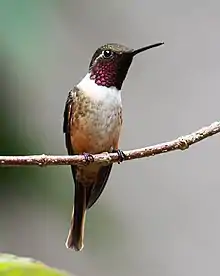Calliphlox
Calliphlox is a genus of hummingbird in the family Trochilidae.
| Calliphlox | |
|---|---|
.jpg.webp) | |
| Amethyst woodstar, Calliphlox amethystina | |
| Scientific classification | |
| Kingdom: | Animalia |
| Phylum: | Chordata |
| Class: | Aves |
| Order: | Apodiformes |
| Family: | Trochilidae |
| Tribe: | Mellisugini |
| Genus: | Calliphlox F. Boie, 1831 |
| Species | |
|
3, see text | |
| Synonyms | |
|
Philodice | |
The genus was introduced by the German zoologist Friedrich Boie in 1831.[1] The type species was subsequently designated as the amethyst woodstar (Calliphlox amethystina).[2] The generic name is derived from the Ancient Greek kalliphlox meaning "beautifully blazing".[3]
It contains the following three species:[4]
| Image | Name | Common name | Distribution |
|---|---|---|---|
 | Calliphlox bryantae | Magenta-throated woodstar | Costa Rica and Panama |
_-_Macho_(17012130495).jpg.webp) | Calliphlox mitchellii | Purple-throated woodstar | Colombia and Ecuador, and a minor localized population in Panama |
.jpg.webp) | Calliphlox amethystina | Amethyst woodstar | Argentina, Bolivia, Brazil, Colombia, Ecuador, French Guiana, Guyana, Suriname-(the Guianas), Paraguay, Peru, and Venezuela |
A molecular phylogenetic study of the hummingbird family published in 2014 found that Calliphlox was polyphyletic.[5] The polyphyly was confirmed in 2017 by a more detailed study restricted to species in tribe Mellisugini.[6] Based on these results, the genus Nesophlox was resurrected for the Bahama woodstar and the Inagua woodstar.[4] Proposals have been submitted to the classification committees of the American Ornithological Society to resurrect of the genus Philodice to accommodate the purple-throated woodstar and the amethyst woodstar.[7][8]
References
- Boie, Friedrich (1831). "Bemerkungen über Species und einige ornithologische Familien und Sippen". Isis von Oken (in German). Cols 538–548 [544].
- Peters, James Lee, ed. (1945). Check-list of Birds of the World. Volume 5. Cambridge, Massachusetts: Harvard University Press. p. 135.
- Jobling, James A. (2010). The Helm Dictionary of Scientific Bird Names. London: Christopher Helm. p. 85. ISBN 978-1-4081-2501-4.
- Gill, Frank; Donsker, David, eds. (2019). "Hummingbirds". World Bird List Version 9.2. International Ornithologists' Union. Archived from the original on 2 October 2018. Retrieved 22 July 2019.
- McGuire, J.; Witt, C.; Remsen, J.V.; Corl, A.; Rabosky, D.; Altshuler, D.; Dudley, R. (2014). "Molecular phylogenetics and the diversification of hummingbirds". Current Biology. 24 (8): 910–916. doi:10.1016/j.cub.2014.03.016.
- Licona-Vera, Yuyini; Ornelas, Juan Francisco (2017). "The conquering of North America: dated phylogenetic and biogeographic inference of migratory behavior in bee hummingbirds". BMC Evolutionary Biology. 17 (1): 126. doi:10.1186/s12862-017-0980-5.
- Donsker, David B.; Rasmussen, Pamela C.; Mason, Nicholas A. (September 2020). "Proposal 886: Resurrect Philodice as a separate genus from Calliphlox". South American Classification Committee, American Ornithological Society. Retrieved 12 January 2020.
- Donsker, David B.; Rasmussen, Pamela C.; Mason, Nicholas A. (8 September 2020). Proposal 2021-A-12: Resurrect Philodice as a separate genus from Calliphlox (PDF) (Report). North American Classification Committee, American Ornithological Society. pp. 63–66.